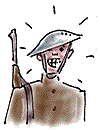home |
many pasts |
evidence |
www.history |
blackboard |
reference
talking history | syllabi | students | teachers | puzzle | about us
talking history | syllabi | students | teachers | puzzle | about us
Words of War
When the U.S. entered World War One in 1918 many Americans believed it would be the “war to end all wars.” The Great War (as American veterans called it), of course, did not end war. But it did introduce many new words. Here are 4 words that entered the American vocabulary or were altered in meaning during World War One. Guess the derivation of the words’ meaning from the choices provided.
|
A tank, which was used by the British for the first time at the Battle of Flers-Courcelette on September 15, 1916, got its name: | |||||||||

|
|
||||||||
| KP, the term for doing kitchen chores and cleanup, originated: | |||||||||
|

| ||||||||
| A dog tag, a metal identification badge worn around the neck to distinguish someone in case of injury or death, was called this because: | |||||||||
 |
|
||||||||
| Doughboy, as a term for American soldiers, was first used during the Civil War, but it came into wide use during World War I. It came from: | |||||||||
|

| ||||||||
